Modelling the Hydrological Effects of Woodland Planting on Infiltration and Peak Discharge Using HEC-HMS
Abstract
:1. Introduction
2. Materials and Methods
2.1. Infiltration Data Collection
2.2. Hydrometric Data Collection and HEC-HMS Modelling
2.3. Model Calibration
2.4. Model Validation
2.5. Model Boundary Conditions
2.5.1. Precipitation and AEP Events
2.5.2. Infiltration Data
2.5.3. Interception
2.5.4. Baseflow
2.6. Hydrological Simulations
3. Results
4. Discussion
4.1. Woodland Planting Mentality
4.2. The Influence of Precipitation, Interception, and Model Calibration
4.3. Antecedent Conditions and Results
4.4. Study Applications
5. Conclusions and Future Work
- Woodland planting across the HofE site shows less of a peak flow compared to impermeable land cover simulations; however, the discrepancy is small and reduces with increase storm duration and intensity.
- The grassland simulations result in the lowest peak flows, regardless of season or storm scenario.
- The summer simulations show significantly higher peak flows compared to winter values across all land cover types in the lower duration storms (6- and 24-h); however this is less significant in the higher duration simulations (96-h).
Author Contributions
Funding
Data Availability Statement
Acknowledgments
Conflicts of Interest
References
- Ellis, N.; Anderson, K.; Brazier, R. Mainstreaming natural flood management: A proposed research framework derived from a critical evaluation of current knowledge. Prog. Phys. Geogr. Earth Environ. 2021, 1–23. [Google Scholar] [CrossRef]
- Ferguson, C.; Fenner, R. The impact of Natural Flood Management on the performance of surface drainage systems: A case study in the Calder Valley. J. Hydrol. 2020, 590, 125354. [Google Scholar] [CrossRef]
- Lowe, J.A.; Bernie, D.; Bett, P.; Bricheno, L.; Brown, S.; Calvert, D.; Clark, R.; Edwards, T.; Fosser, G.; Fung, F.; et al. UKCP18 Science Overview Report; Met Office: Exeter, UK, 2019.
- Murphy, T.R.; Hanley, M.E.; Ellis, J.S.; Lunt, P.H. Native woodland establishment improves soil hydrological functioning in UK upland pastoral catchments. Land Degrad. Dev. 2021, 32, 1034–1045. [Google Scholar] [CrossRef]
- Shuttleworth, E.L.; Evans, M.G.; Pilkington, M.; Spencer, T.; Walker, J.; Milledge, D.; Allott, T.E.H. Restoration of blanket peat moorland delays stormflow from hillslopes and reduces peak discharge. J. Hydrol. X 2019, 2, 100006. [Google Scholar] [CrossRef]
- Metcalfe, P.; Beven, K.; Hankin, B.; Lamb, R. A new method, with application, for analysis of the impacts on flood risk of widely distributed enhanced hillslope storage. Hydrol. Earth Syst. Sci. 2018, 22, 2589–2605. [Google Scholar] [CrossRef] [Green Version]
- Forbes, H.; Ball, K.; McLay, F. Natural Flood Management Handbook; Scottish Environment Protection Agency: Stirling, UK, 2016; ISBN 978-0-85759-024-4.
- Ferguson, C.R.; Fenner, R.A. The potential for natural flood management to maintain free discharge at urban drainage outfalls. J. Flood Risk Manag. 2020, 13, 1–15. [Google Scholar] [CrossRef]
- Dadson, S.J.; Hall, J.W.; Murgatroyd, A.; Acreman, M.; Bates, P.; Beven, K.; Heathwaite, L.; Holden, J.; Holman, I.P.; Lane, S.N.; et al. A restatement of the natural science evidence concerning catchment-based “natural” flood management in the UK. Proc. R. Soc. A Math. Phys. Eng. Sci. 2017, 473, 20160706. [Google Scholar] [CrossRef] [PubMed] [Green Version]
- Burgess-Gamble, L.; Ngai, R.; Wilkinson, M.; Nisbet, T.; Pontee, N.; Harvey, R.; Kipling, K.; Addy, S.; Rose, S.; Maslen, S.; et al. Working with Natural Processes—Evidence Directory; Environment Agency: Bristol, UK, 2018.
- Rachelle, N.; Wilkinson, M.; Nisbet, T.; Harvey, R.; Addy, S.; Burgess-Gamble, L.; Rose, S.; Maslen, S.; Nicholson, A.; Page, T.; et al. Working with Natural Processes—Evidence Directory Appendix 2: Literature Review; Environment Agency: Bristol, UK, 2017.
- Wells, J.; Labadz, J.C.; Smith, A.; Islam, M.M. Barriers to the uptake and implementation of natural flood management: A social-ecological analysis. J. Flood Risk Manag. 2020, 13, 1–12. [Google Scholar] [CrossRef]
- Lacob, O.; Rowan, J.S.; Brown, I.; Ellis, C. Evaluating wider benefits of natural flood management strategies: An ecosystem-based adaptation perspective. Hydrol. Res. 2014, 45, 774–787. [Google Scholar] [CrossRef] [Green Version]
- Dittrich, R.; Ball, T.; Wreford, A.; Moran, D.; Spray, C.J. A cost-benefit analysis of afforestation as a climate change adaptation measure to reduce flood risk. J. Flood Risk Manag. 2019, 12, 1–11. [Google Scholar] [CrossRef] [Green Version]
- Chandler, K.R.; Stevens, C.J.; Binley, A.; Keith, A.M. Influence of tree species and forest land use on soil hydraulic conductivity and implications for surface runoff generation. Geoderma 2018, 310, 120–127. [Google Scholar] [CrossRef] [Green Version]
- Zhang, D.; Wang, Z.; Guo, Q.; Lian, J.; Chen, L. Increase and Spatial Variation in Soil Infiltration Rates Associated with Fibrous and Tap Tree Roots. Water 2019, 11, 1700. [Google Scholar] [CrossRef] [Green Version]
- GOV.UK. £3.9 Million to Drive Innovative Tree Planting. Available online: https://www.gov.uk/government/news/39-million-to-drive-innovative-tree-planting (accessed on 13 July 2021).
- Murphy, T. Optimising Oak Woodland Establishment into UK Upland Pastures in the Context of Climate Change; And the Role of Oak Woodland in Soil Hydrological Recovery for Natural Flood Management; University of Plymouth: Plymouth, UK, 2021. [Google Scholar]
- Ordnance Survey Ordnance Survey Open Data Download. Available online: https://www.ordnancesurvey.co.uk/opendatadownload/products.html (accessed on 15 February 2019).
- Ren, X.; Hong, N.; Li, L.; Kang, J.; Li, J. Effect of infiltration rate changes in urban soils on stormwater runoff process. Geoderma 2020, 363. [Google Scholar] [CrossRef]
- Bátková, K.; Miháliková, M.; Matula, S. Hydraulic properties of a cultivated soil in temperate continental climate determined by mini disk infiltrometer. Water 2020, 12, 843. [Google Scholar] [CrossRef] [Green Version]
- Rahman, M.A.; Moser, A.; Anderson, M.; Zhang, C.; Rötzer, T.; Pauleit, S. Comparing the infiltration potentials of soils beneath the canopies of two contrasting urban tree species. Urban For. Urban Green. 2019, 38, 22–32. [Google Scholar] [CrossRef]
- LaMotte Soil Texture Test Kit. Available online: https://lamotte.com/products/soil/individual-soil-plant-tissue-test-kits/soil-texture-test-1067 (accessed on 15 October 2020).
- METER® Group Inc. Mini Disk Infiltrometer User’s Manual; METER: Pullman, WA, USA, 2018. [Google Scholar]
- Hepner, H.; Lutter, R.; Tullus, A.; Kanal, A.; Tullus, T.; Tullus, H. Effect of Early Thinning Treatments on Above-Ground Growth, Biomass Production, Leaf Area Index and Leaf Growth Efficiency in a Hybrid Aspen Coppice Stand. Bioenergy Res. 2020, 13, 197–209. [Google Scholar] [CrossRef]
- Mauer, O.; Palátová, E. The role of root system in silver birch (Betula pendula Roth) dieback in the air-polluted area of Krušné hory Mts. J. For. Sci. 2003, 49, 191–199. [Google Scholar] [CrossRef] [Green Version]
- Perry, T.O. Tree Roots: Facts and Fallacies. J. Arboric. 1982, 8, 197–211. [Google Scholar]
- Bagarello, V.; Sgroi, A. Using the single-ring infiltrometer method to detect temporal changes in surface soil field-saturated hydraulic conductivity. Soil Tillage Res. 2004, 76, 13–24. [Google Scholar] [CrossRef]
- NextGen. NextGen Spernal, UK. Available online: https://nextgenwater.eu/demonstration-cases/spernal/ (accessed on 16 March 2020).
- Terink, W.; Leijnse, H.; van den Eertwegh, G.; Uijlenhoet, R. Spatial resolutions in areal rainfall estimation and their impact on hydrological simulations of a lowland catchment. J. Hydrol. 2018, 563, 319–335. [Google Scholar] [CrossRef]
- Roberts, N. Assessing the spatial and temporal variation in the skill of precipitation forecasts from an NWP model. Meteorol. Appl. 2008, 15, 163–169. [Google Scholar] [CrossRef] [Green Version]
- Maier, R.; Krebs, G.; Pichler, M.; Muschalla, D.; Gruber, G. Spatial Rainfall Variability in Urban Environments—High-Density Precipitation Measurements on a City-Scale. Water 2020, 12, 1157. [Google Scholar] [CrossRef] [Green Version]
- Malik, S.; Pal, S.C. Application of 2D numerical simulation for rating curve development and inundation area mapping: A case study of monsoon dominated Dwarkeswar river. Int. J. River Basin Manag. 2020, 1–11. [Google Scholar] [CrossRef]
- Rampinelli, C.G.; Knack, I.; Smith, T. Flood mapping uncertainty from a restoration perspective: A practical case study. Water 2020, 12, 1948. [Google Scholar] [CrossRef]
- Derdour, A.; Bouanani, A.; Babahamed, K. Modelling rainfall runoff relations using HEC-HMS in a semi-arid region: Case study in Ain Sefra watershed, Ksour Mountains (SW Algeria). J. Water Land Dev. 2018, 36, 45–55. [Google Scholar] [CrossRef] [Green Version]
- Joshi, N.; Bista, A.; Pokhrel, I.; Kalra, A.; Ahmad, S. Rainfall-Runoff Simulation in Cache River Basin, Illinois, Using HEC-HMS. In Proceedings of the World Environmental and Water Resources Congress 2019, Pittsburgh, PA, USA, 19–23 May 2019; American Society of Civil Engineers: Reston, VA, USA, 2019; pp. 348–360. [Google Scholar]
- Al-Mukhtar, M.; Al-Yaseen, F. Modeling water quality parameters using data-driven models, a case study Abu-Ziriq marsh in south of Iraq. Hydrology 2019, 6, 24. [Google Scholar] [CrossRef] [Green Version]
- Rangari, V.A.; Sridhar, V.; Umamahesh, N.V.; Patel, A.K. Rainfall Runoff Modelling of Urban Area Using HEC-HMS: A Case Study of Hyderabad City. In Advances in Water Resources Engineering and Management; AlKhaddar, R., Singh, R.K., Dutta, S., Kumari, M., Eds.; Lecture Notes in Civil Engineering; Springer: Singapore, 2020; Volume 39, pp. 113–125. ISBN 978-981-13-8180-5. [Google Scholar]
- Department for Environment Food & Rural Affairs LIDAR Composite DTM. Available online: https://environment.data.gov.uk/dataset/668881ad-4f8f-42bd-b835-89acf0269496 (accessed on 16 July 2021).
- Kafle, M.R. Rainfall-Runoff Modelling of Koshi River Basin Using HEC-HMS. J. Hydogeol. Hydrol. Eng. 2019, 8, 1–9. [Google Scholar]
- Ramly, S.; Tahir, W.; Abdullah, J.; Jani, J.; Ramli, S.; Asmat, A. Flood Estimation for SMART Control Operation Using Integrated Radar Rainfall Input with the HEC-HMS Model. Water Resour. Manag. 2020, 34, 3113–3127. [Google Scholar] [CrossRef]
- Cunge, J.A. On the subject of a flood propagation computation method (Maskingum method). J. Hydraul. Res. 1969, 7, 205–230. [Google Scholar] [CrossRef]
- Dong, X. How to put plant root uptake into a soil water flow model. F1000Research 2016, 5, 1–9. [Google Scholar] [CrossRef] [Green Version]
- Broadbridge, P.; Daly, E.; Goard, J. Exact Solutions of the Richards Equation with Nonlinear Plant-Root Extraction. Water Resour. Res. 2017, 53, 9679–9691. [Google Scholar] [CrossRef]
- Kuhlmann, A.; Neuweiler, I.; Van Der Zee, S.E.A.T.M.; Helmig, R. Influence of soil structure and root water uptake strategy on unsaturated flow in heterogeneous media. Water Resour. Res. 2012, 48, 1–16. [Google Scholar] [CrossRef]
- Blengino Albrieu, J.L.; Reginato, J.C.; Tarzia, D.A. Modeling water uptake by a root system growing in a fixed soil volume. Appl. Math. Model. 2015, 39, 3434–3447. [Google Scholar] [CrossRef]
- Difonzo, F.V.; Masciopinto, C.; Vurro, M.; Berardi, M. Shooting the Numerical Solution of Moisture Flow Equation with Root Water Uptake Models: A Python Tool. Water Resour. Manag. 2021, 35, 2553–2567. [Google Scholar] [CrossRef]
- Darya, F.; Pavel, K.; Jan, G.; Andrea, J.; Jana, N. The use of Snyder synthetic hydrograph for simulation of overland flow in small ungauged and gauged catchments. Soil Water Res. 2018, 13, 185–192. [Google Scholar] [CrossRef] [Green Version]
- Zelelew, D.G.; Melesse, A.M. Applicability of a spatially semi-distributed hydrological model for watershed scale runoff estimation in Northwest Ethiopia. Water 2018, 10, 923. [Google Scholar] [CrossRef] [Green Version]
- Koneti, S.; Sunkara, S.L.; Roy, P.S. Hydrological modeling with respect to impact of land-use and land-cover change on the runoff dynamics in Godavari river basin using the HEC-HMS model. ISPRS Int. J. Geo-Inf. 2018, 7, 206. [Google Scholar] [CrossRef] [Green Version]
- Met Office UK Climate Averages. Available online: https://www.metoffice.gov.uk/research/climate/maps-and-data/uk-climate-averages/gcq89t680 (accessed on 23 September 2021).
- Kumarasamy, K.; Belmont, P. Calibration parameter selection and watershed hydrology model evaluation in time and frequency domains. Water 2018, 10, 710. [Google Scholar] [CrossRef] [Green Version]
- Nash, J.E.; Sutcliffe, J.V. River flow forecasting through conceptual models Part I—A discussion of principles. J. Hydrol. 1970, 10, 282–290. [Google Scholar] [CrossRef]
- Naik, A.P.; Ghosh, B.; Pekkat, S. Estimating soil hydraulic properties using mini disk infiltrometer. ISH J. Hydraul. Eng. 2019, 25, 62–70. [Google Scholar] [CrossRef]
- McMillan, H.K.; Booker, D.J.; Cattoën, C. Validation of a national hydrological model. J. Hydrol. 2016, 541, 800–815. [Google Scholar] [CrossRef]
- UK Centre for Ecology and Hydrology. The Flood Estimation Handbook; UK Centre for Ecology and Hydrology: Wallingford, UK, 1999; Available online: https://www.ceh.ac.uk/services/flood-estimation-handbook (accessed on 12 July 2021).
- Darwish, M.M.; Tye, M.R.; Prein, A.F.; Fowler, H.J.; Blenkinsop, S.; Dale, M.; Faulkner, D. New hourly extreme precipitation regions and regional annual probability estimates for the UK. Int. J. Climatol. 2021, 41, 582–600. [Google Scholar] [CrossRef]
- Wobus, C.; Gutmann, E.; Jones, R.; Rissing, M.; Mizukami, N.; Lorie, M.; Mahoney, H.; Wood, A.; Mills, D.; Martinich, J. Modeled changes in 100 year Flood Risk and Asset Damages within Mapped Floodplains of the Contiguous United States. Nat. Hazards Earth Syst. Sci. Discuss. 2017, 1–21. [Google Scholar] [CrossRef] [Green Version]
- Local Authority SuDS Officer Organisation (LASOO). Non-Statutory Technical Standards for Sustainable Drainage; LASOO: London, UK, 2016. [Google Scholar]
- Department for Environment, Food and Rural Affairs. Draft National Standards and Specified Criteria for Sustainable Drainage; Defra: London, UK, 2014.
- Klamerus-Iwan, A. Different views on tree interception process and its determinants. For. Res. Pap. 2014, 75, 291–300. [Google Scholar] [CrossRef] [Green Version]
- Rahman, M.; Ennos, R. What We Know and Don’t Know about the Surface Runoff Reduction Potential of Urban Trees; Technical Report; Technical University of Munich: Munich, Germany, 2016; pp. 1–14. [Google Scholar]
- Komatsu, H.; Kume, T.; Otsuki, K. Increasing annual runoff-broadleaf or coniferous forests? Hydrol. Process. 2011, 25, 302–318. [Google Scholar] [CrossRef]
- Nisbet, T. Water Use by Trees; Information Note FCIN065; Forestry Commission: Edinburgh, UK, 2005; pp. 1–8.
- Calder, I.R. Assessing the water use of short vegetation and forests: Development of the Hydrological Land Use Change (HYLUC) model. Water Resour. Res. 2003, 39, 1–8. [Google Scholar] [CrossRef]
- Lunka, P.; Patil, S.D. Impact of tree planting configuration and grazing restriction on canopy interception and soil hydrological properties: Implications for flood mitigation in silvopastoral systems. Hydrol. Process. 2016, 30, 945–958. [Google Scholar] [CrossRef] [Green Version]
- Schütte, S.; Schulze, R.E. Projected impacts of urbanisation on hydrological resource flows: A case study within the uMngeni Catchment, South Africa. J. Environ. Manag. 2017, 196, 527–543. [Google Scholar] [CrossRef]
- Yusop, Z.; Chan, C.H.; Katimon, A. Runoff characteristics and application of HEC-HMS for modelling stormflow hydrograph in an oil palm catchment. Water Sci. Technol. 2007, 56, 41–48. [Google Scholar] [CrossRef] [Green Version]
- Randrup, T.B. A review of tree root conflicts with sidewalks, curbs, and roads. Urban Ecosyst. 2001, 5, 209–225. [Google Scholar] [CrossRef]
- Birkinshaw, S.J.; Bathurst, J.C.; Robinson, M. 45 years of non-stationary hydrology over a forest plantation growth cycle, Coalburn catchment, Northern England. J. Hydrol. 2014, 519, 559–573. [Google Scholar] [CrossRef] [Green Version]
- Lee, S.J.; Connolly, T.; Wilson, S.M.; Malcolm, D.C.; Fonweban, J.; Worrell, R.; Hubert, J.; Sykes, R.J. Early height growth of silver birch (Betula pendula Roth) provenances and implications for choice of planting stock in Britain. Forestry 2015, 88, 484–499. [Google Scholar] [CrossRef] [Green Version]
- Kuparinen, A.; Savolainen, O.; Schurr, F.M. Increased mortality can promote evolutionary adaptation of forest trees to climate change. For. Ecol. Manag. 2010, 259, 1003–1008. [Google Scholar] [CrossRef]
- Zeltiņš, P.; Gailis, A.; Jansons, J.; Katrevičs, J.; Jansons, Ā. Genetic Parameters of Growth Traits and Stem Quality of Silver Birch in a Low-Density Clonal Plantation. Forests 2018, 9, 52. [Google Scholar] [CrossRef] [Green Version]
- Hynynen, J.; Niemisto, P.; Vihera-Aarnio, A.; Brunner, A.; Hein, S.; Velling, P. Silviculture of birch (Betula pendula Roth and Betula pubescens Ehrh.) in northern Europe. Forestry 2010, 83, 103–119. [Google Scholar] [CrossRef]
- CAB International. The CABI Encyclopedia of Forest Trees; CABI Publishing: Wallingford, UK, 2013; ISBN 9781780642369. [Google Scholar]
- Savill, P. The Silviculture of Trees Used in British Forestry, 3rd ed.; CABI Publishing: Wallingford, UK, 2019. [Google Scholar]
- MacKenzie, N.A. Ecology, Conservation and Management of Aspen: A Literature Review; CABI Publishing: Wallingford, UK, 2010. [Google Scholar]
- Thomas, H.; Nisbet, T.R. Slowing the Flow in Pickering: Quantifying the Effect of Catchment Woodland Planting on Flooding Using the Soil Conservation Service Curve Number Method. Int. J. Saf. Secur. Eng. 2016, 6, 2–20. [Google Scholar]
- Hankin, B.; Chappell, N.; Page, T.; Kipling, K.; Whitling, M.; Burgess-Gamble, L. Mapping the Potential for Working with Natural Processes—Technical Report; Environment Agency: Bristol, UK, 2018.
- Cooper, M.M.D.; Patil, S.D.; Nisbet, T.R.; Thomas, H.; Smith, A.R.; McDonald, M.A. Role of forested land for natural flood management in the UK: A review. Wiley Interdiscip. Rev. Water 2021, 8, 1–16. [Google Scholar] [CrossRef]
- Archer, N.A.L.; Bonell, M.; Coles, N.; MacDonald, A.M.; Auton, C.A.; Stevenson, R. Soil characteristics and landcover relationships on soil hydraulic conductivity at a hillslope scale: A view towards local flood management. J. Hydrol. 2013, 497, 208–222. [Google Scholar] [CrossRef] [Green Version]
- Sharu, E.H. Development of HEC-HMS Model for Flow Simulation at Dungun River Basin Malaysia. Adv. Agric. Food Res. J. 2020, 1, 1–16. [Google Scholar] [CrossRef]
- Hamdan, A.N.A.; Almuktar, S.; Scholz, M. Rainfall-Runoff Modeling Using the HEC-HMS Model for the Al-Adhaim River Catchment, Northern Iraq. Hydrology 2021, 8, 58. [Google Scholar] [CrossRef]
- Folorunso, O.; Aribisala, J. Effect of Soil Texture on Soil Infiltration Rate. Arch. Curr. Res. Int. 2018, 14, 1–8. [Google Scholar] [CrossRef]
- Silber, A. Chemical Characteristics of Soilless Media. In Soilless Culture; Elsevier: Amsterdam, The Netherlands, 2019; pp. 113–148. ISBN 9780444636966. [Google Scholar]
- Rabot, E.; Wiesmeier, M.; Schlüter, S.; Vogel, H.J. Soil structure as an indicator of soil functions: A review. Geoderma 2018, 314, 122–137. [Google Scholar] [CrossRef]
- Sun, D.; Yang, H.; Guan, D.; Yang, M.; Wu, J.; Yuan, F.; Jin, C.; Wang, A.; Zhang, Y. The effects of land use change on soil infiltration capacity in China: A meta-analysis. Sci. Total Environ. 2018, 626, 1394–1401. [Google Scholar] [CrossRef]
- The Met Office Record Breaking Rainfall. Available online: https://www.metoffice.gov.uk/about-us/press-office/news/weather-and-climate/2020/2020-winter-february-stats (accessed on 11 June 2021).
- Davies, P.A.; McCarthy, M.; Christidis, N.; Dunstone, N.; Fereday, D.; Kendon, M.; Knight, J.R.; Scaife, A.A.; Sexton, D. The wet and stormy UK winter of 2019/2020. Weather 2021, wea.3955. [Google Scholar] [CrossRef]
- Groenendyk, D.G.; Ferré, T.P.A.; Thorp, K.R.; Rice, A.K. Hydrologic-process-based soil texture classifications for improved visualization of landscape function. PLoS ONE 2015, 10, e0131299. [Google Scholar] [CrossRef] [Green Version]
- Leung, A.K.; Boldrin, D.; Liang, T.; Wu, Z.Y.; Kamchoom, V.; Bengough, A.G. Plant age effects on soil infiltration rate during early plant establishment. Geotechnique 2018, 68, 646–652. [Google Scholar] [CrossRef] [Green Version]
- British Geological Survey 1:625k Bedrock and Superficial UK Geology. Available online: https://www.bgs.ac.uk/datasets/bgs-geology-625k-digmapgb/ (accessed on 15 June 2021).
- Xie, C.; Cai, S.; Yu, B.; Yan, L.; Liang, A.; Che, S. The effects of tree root density on water infiltration in urban soil based on a Ground Penetrating Radar in Shanghai, China. Urban For. Urban Green. 2020, 50, 126648. [Google Scholar] [CrossRef]
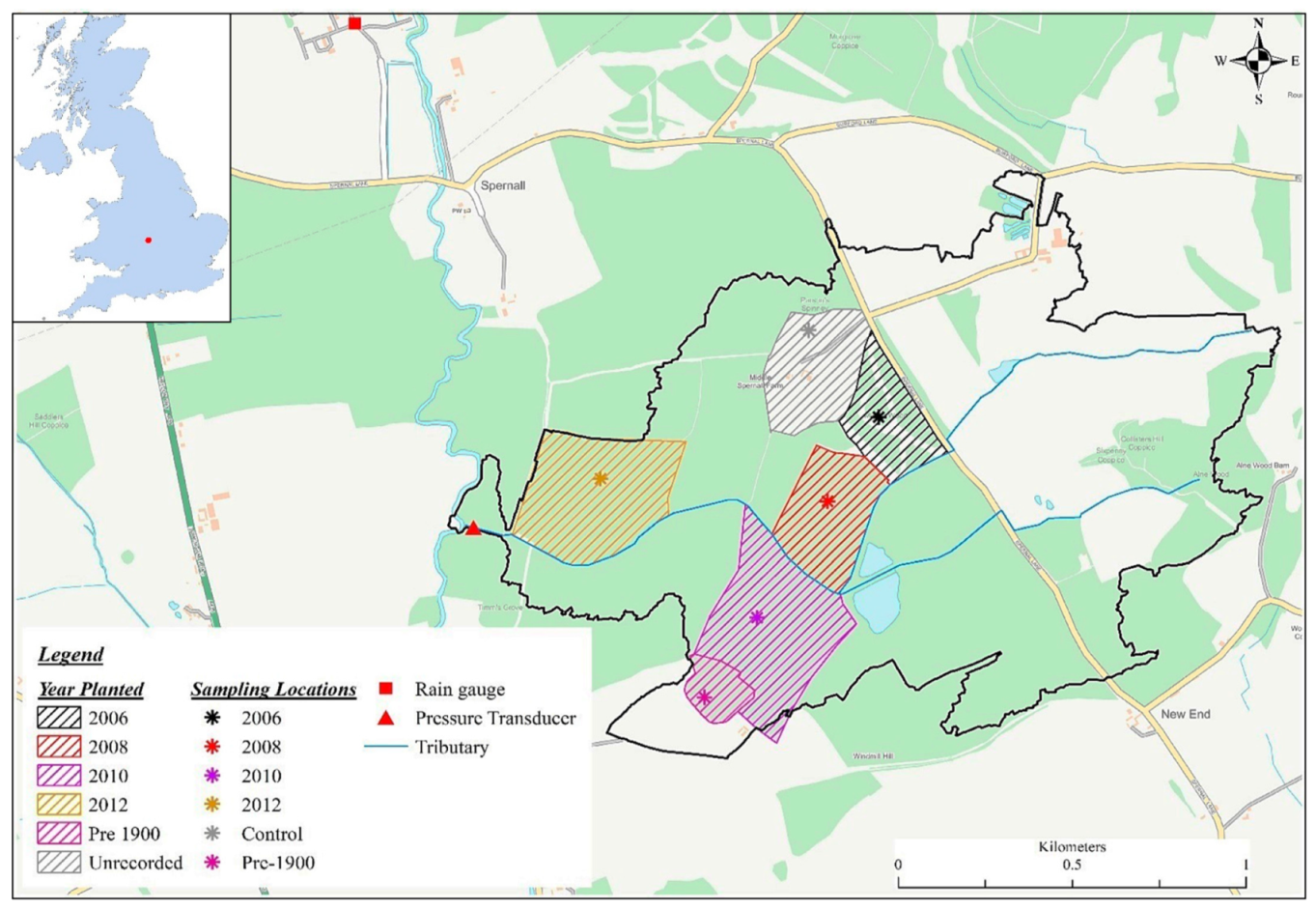
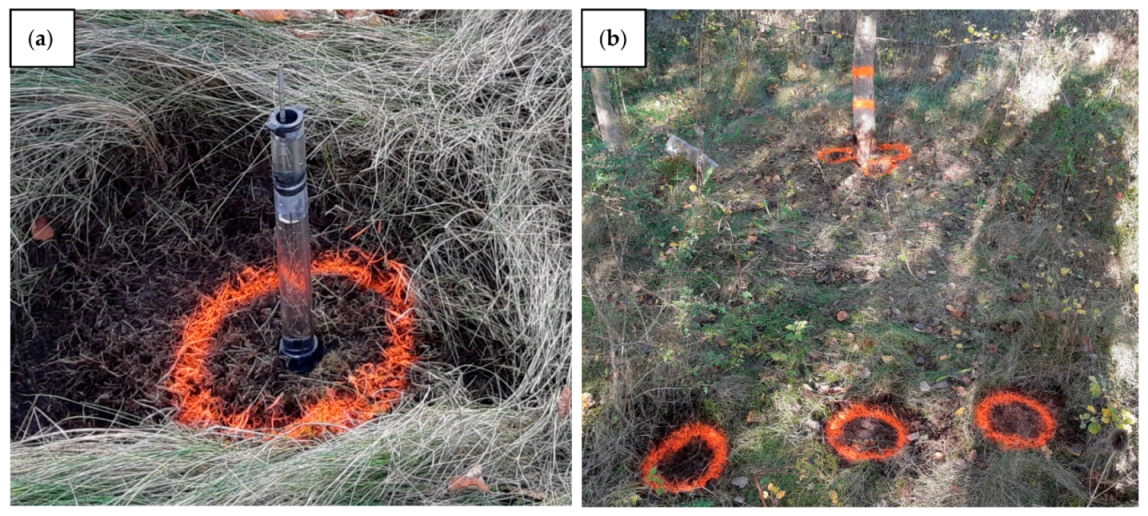
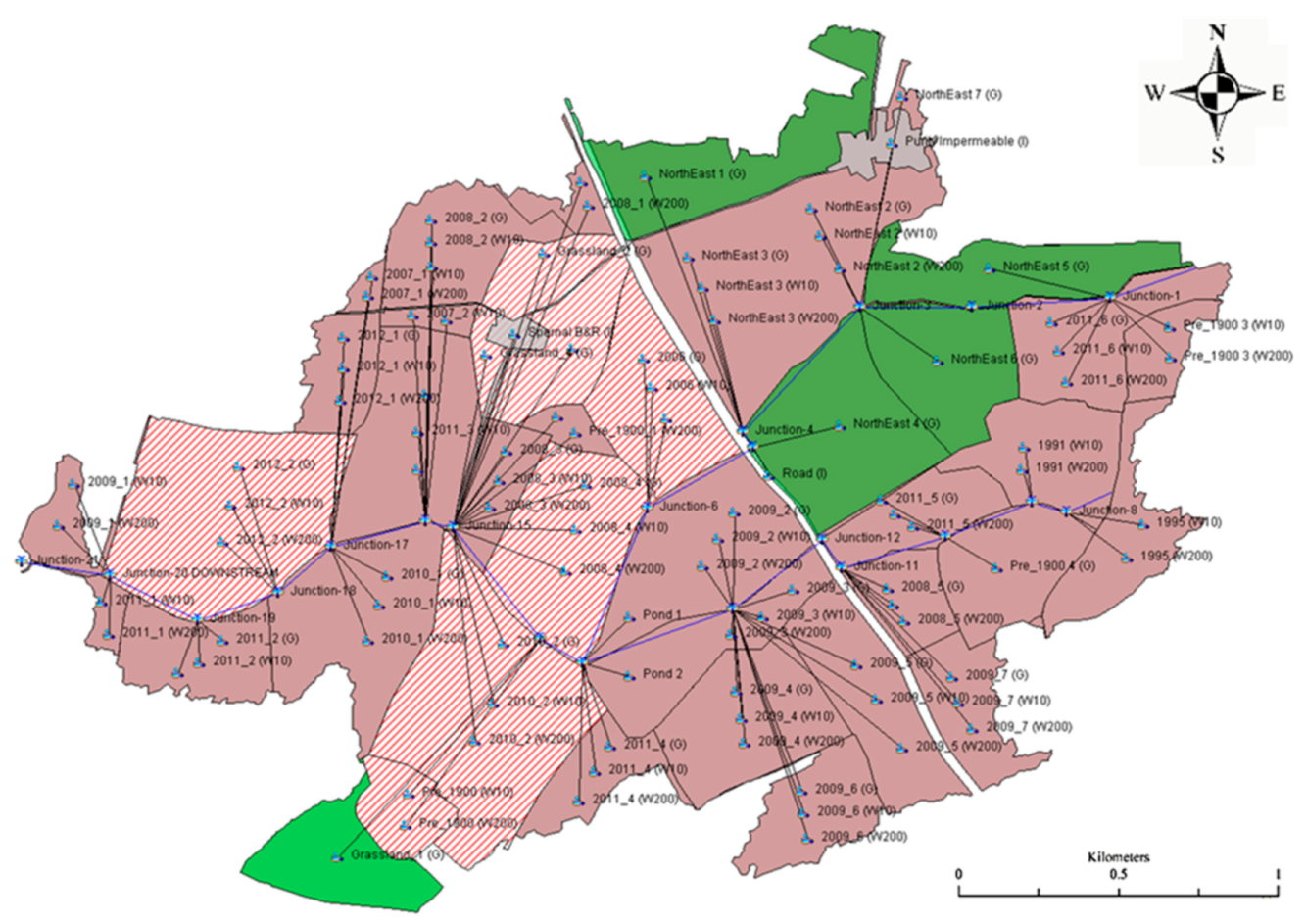
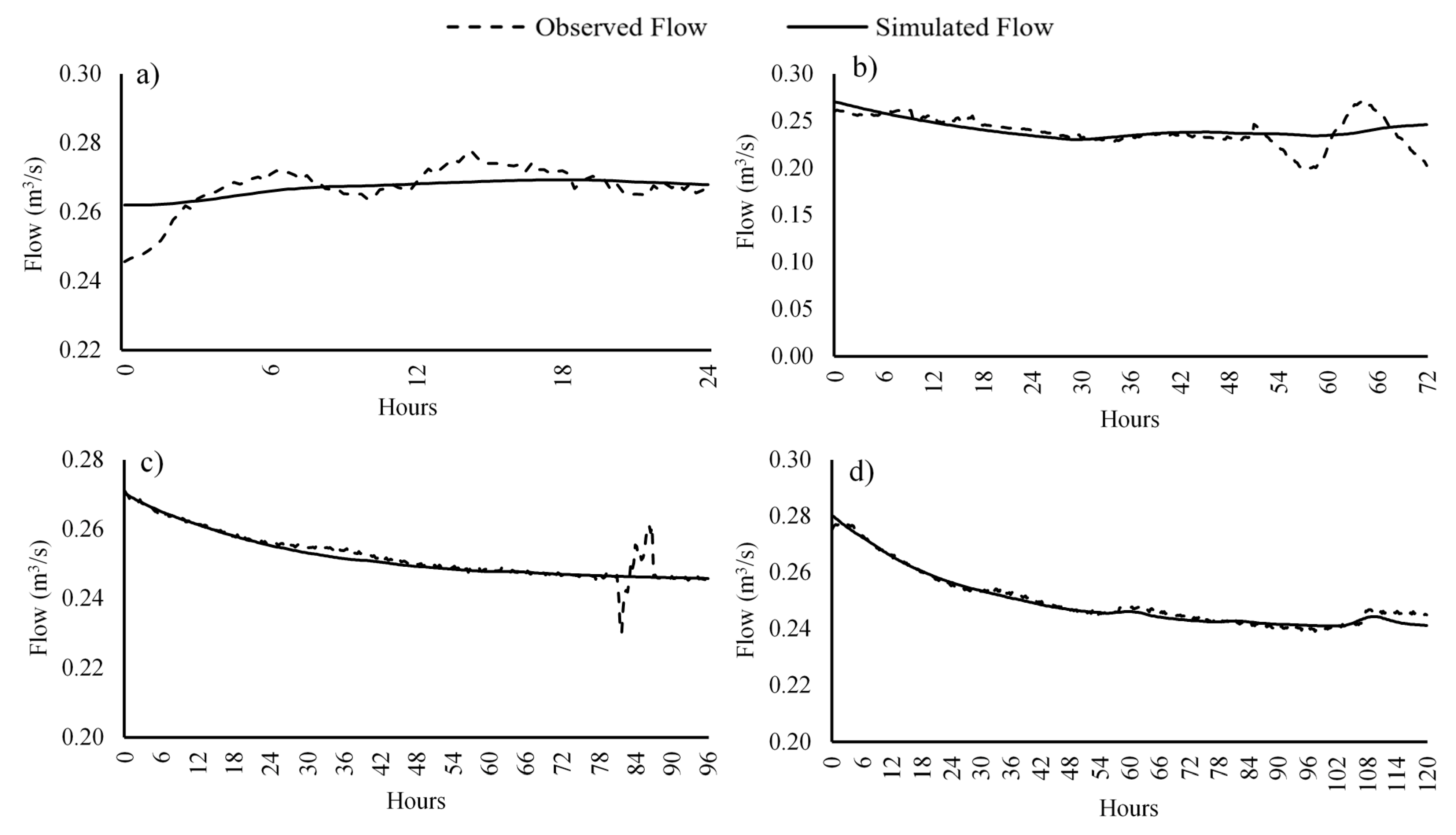

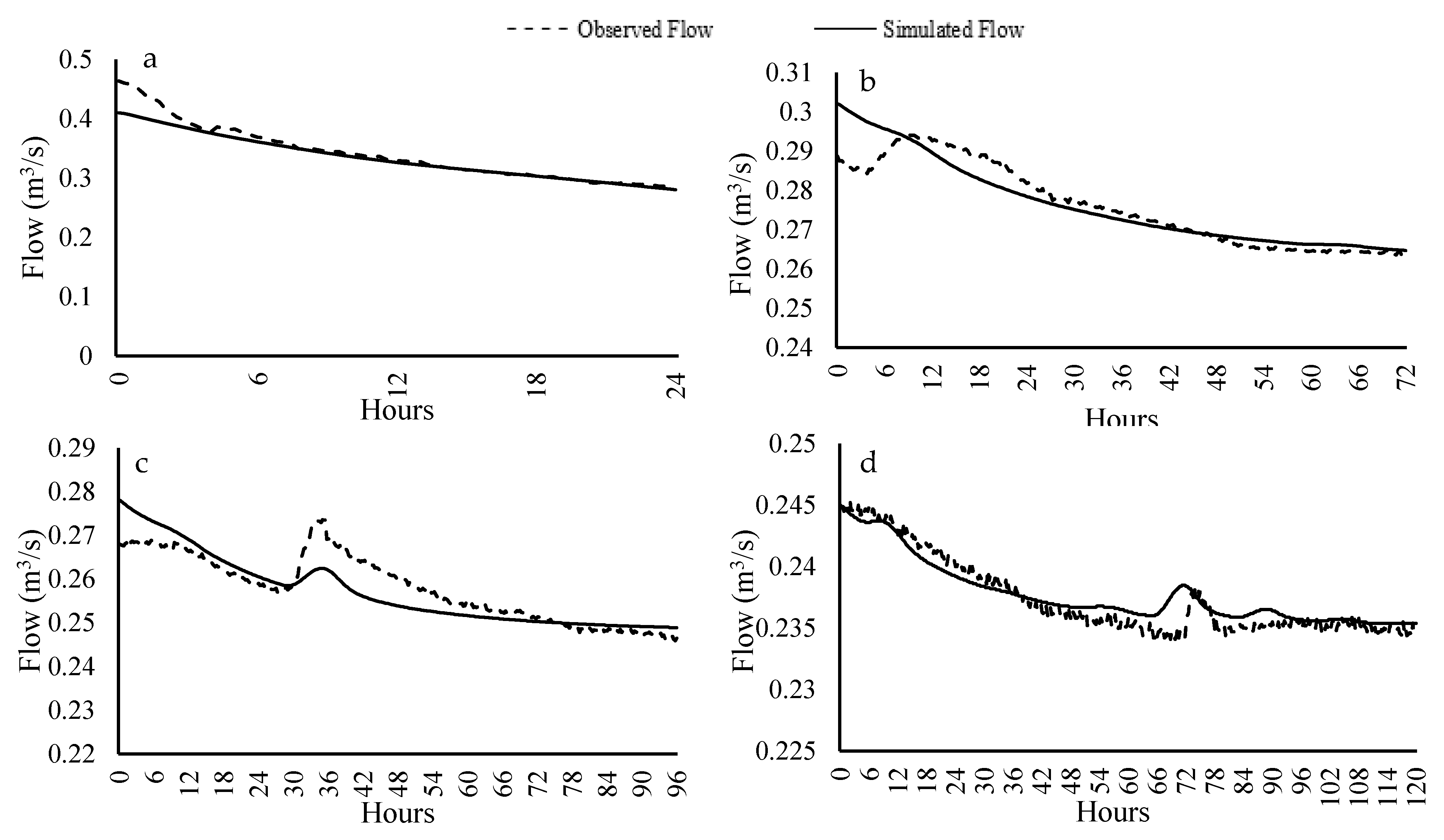
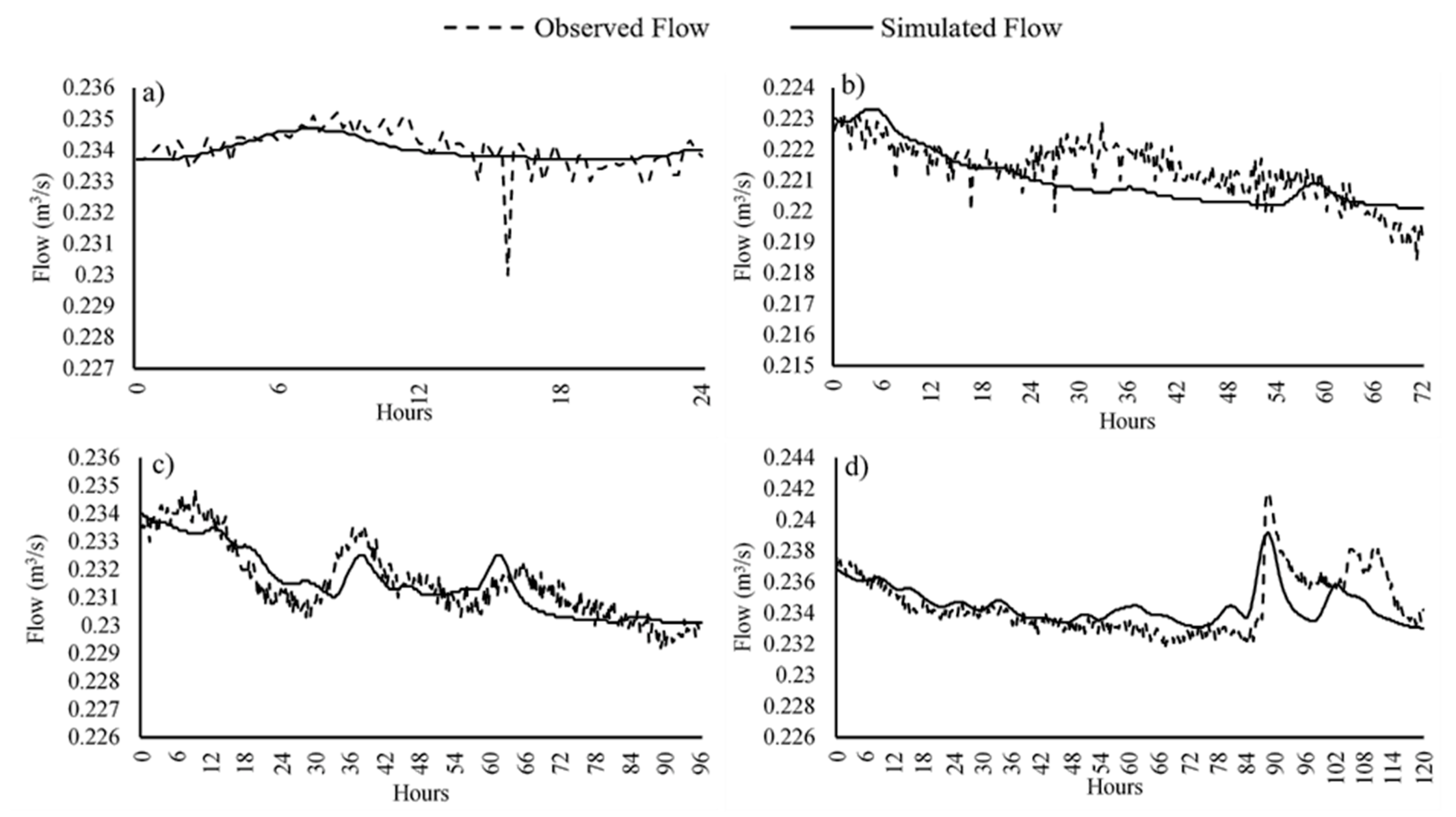
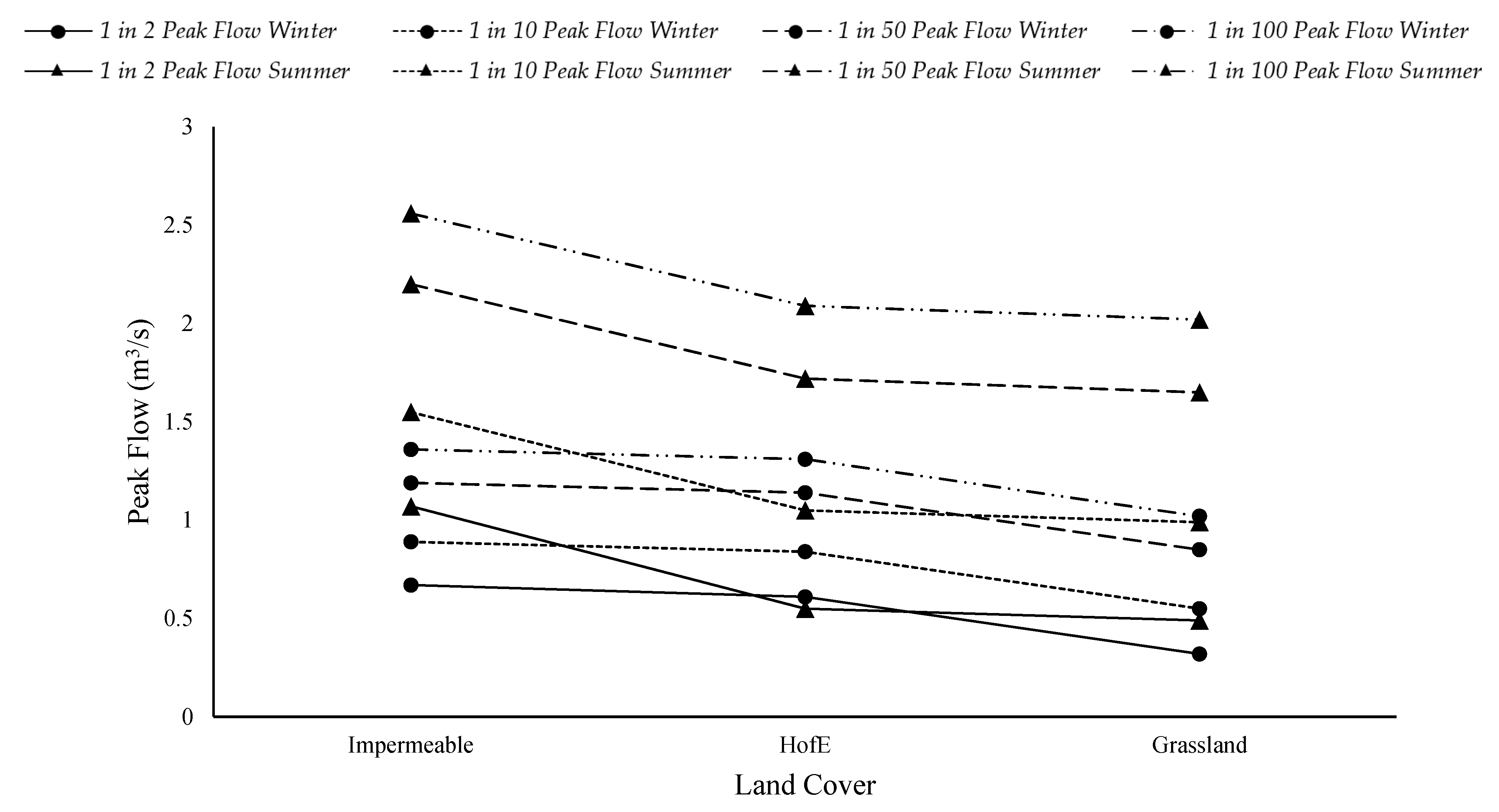
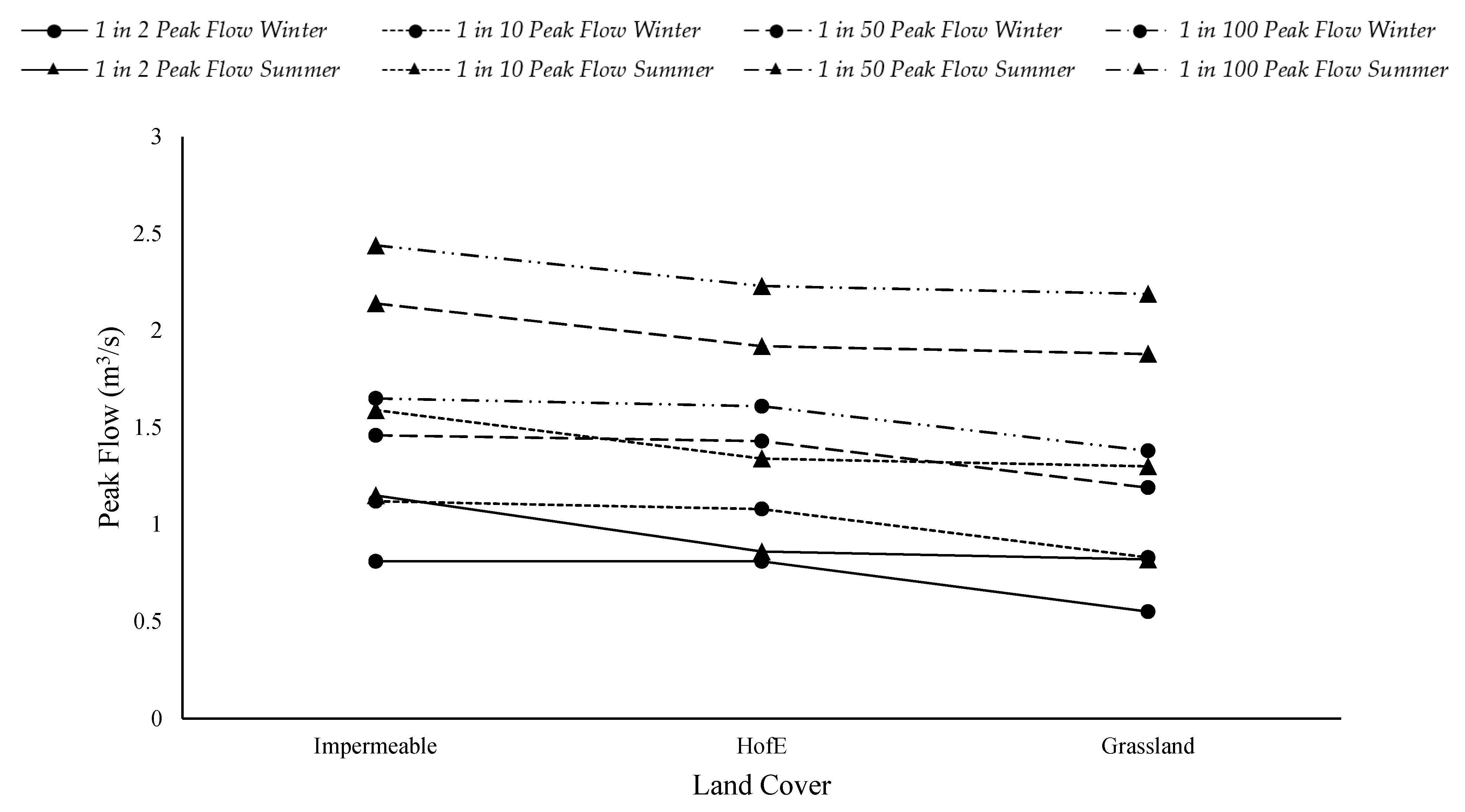

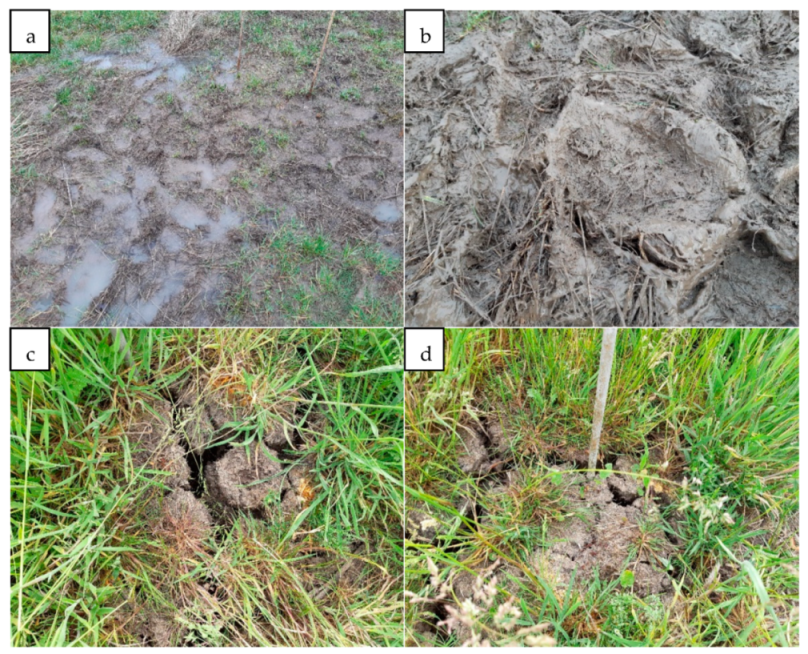
| Sample Site | Sand % | Silt % | Clay % | UK Soil Classification | |
|---|---|---|---|---|---|
| Control | 53 | 20 | 27 | SaCL | Sandy clay loam |
| Pre-1900 | 47 | 40 | 13 | SSL | Sandy silt loam |
| 2006 | 20 | 20 | 60 | C | Clay |
| 2008 | 13 | 20 | 67 | C | Clay |
| 2010 | 53 | 33 | 14 | SaL | Sandy loam |
| 2012 | 33 | 13 | 54 | C | Clay |
| Calibration Events | ||||||
|---|---|---|---|---|---|---|
| Winter | ||||||
| Duration (h) | Start Date | Start Time | End Date | End Time | Rainfall (mm) | NSE |
| 24 | 16 January 2021 | 04:00 | 17 January 2021 | 04:00 | 1.8 | 0.41 |
| 72 | 17 January 2021 | 16:00 | 20 January 2021 | 16:00 | 10.60 | 0.30 |
| 96 | 30 November 2019 | 04:00 | 04 December 2019 | 04:00 | 0.80 | 0.92 |
| 120 | 08 October 2020 | 07:00 | 13 October 2020 | 07:00 | 6.70 | 0.98 |
| Summer | ||||||
| 24 | 09 September 2020 | 03:00 | 10 September 2020 | 03:00 | 1.20 | 0.62 |
| 72 | 19 August 2020 | 07:00 | 22 August 2020 | 07:00 | 19.60 | 0.80 |
| 96 | 01 August 2020 | 01:00 | 05 August 2020 | 01:00 | 7.90 | 0.29 |
| 120 | 28 August 2020 | 07:00 | 02 September 2020 | 07:00 | 13.40 | 0.89 |
| Validation Events | ||||||
|---|---|---|---|---|---|---|
| Winter | ||||||
| Duration (h) | Start Date | Start Time | End Date | End Time | Rainfall (mm) | NSE |
| 24 | 14 January 2021 | 04:30 | 15 January 2021 | 04:30 | 1.10 | 0.90 |
| 72 | 06 December 2020 | 07:00 | 09 December 2020 | 07:00 | 2.70 | 0.81 |
| 96 | 02 November 2020 | 01:00 | 06 November 2020 | 01:00 | 6.70 | 0.87 |
| 120 | 13 October 2020 | 07:00 | 18 October 2020 | 07:00 | 4.50 | 0.88 |
| Summer | ||||||
| 24 | 04 September 2020 | 02:00 | 05 September 2020 | 02:00 | 0.70 | 0.35 |
| 72 | 09 September 2020 | 22:00 | 12 September 2020 | 22:00 | 1.00 | 0.23 |
| 96 | 04 September 2020 | 22:00 | 08 September 2020 | 22:00 | 4.20 | 0.74 |
| 120 | 30 August 2020 | 02:00 | 04 September 2020 | 02:00 | 8.00 | 0.42 |
| 6-h | AEP % | HofE (Wooded Land Cover) (m3 s−1) | Impermeable Land Cover (m3 s−1) | Change from HofE (as %) | Grassland Land Cover (m3 s−1) | Change from HofE (as %) |
|---|---|---|---|---|---|---|
| Winter | ||||||
| Peak volume | 50 | 0.61 | 0.67 | 9.84 | 0.32 | −47.54 |
| 10 | 0.84 | 0.89 | 5.95 | 0.55 | −34.52 | |
| 2 | 1.14 | 1.19 | 4.39 | 0.85 | −25.44 | |
| 1 | 1.31 | 1.36 | 3.82 | 1.02 | −22.14 | |
| Summer | ||||||
| Peak volume | 50 | 0.55 | 1.07 | 94.55 | 0.49 | −10.91 |
| 10 | 1.05 | 1.55 | 47.62 | 0.99 | −5.71 | |
| 2 | 1.72 | 2.2 | 27.91 | 1.65 | −4.07 | |
| 1 | 2.09 | 2.56 | 22.49 | 2.02 | −3.35 | |
| 24-h | AEP % | HofE (Wooded Land Cover) (m3 s−1) | Impermeable Land Cover (m3 s−1) | Change from HofE (as %) | Grassland Land Cover (m3 s−1) | Change from HofE (as %) |
|---|---|---|---|---|---|---|
| Winter | ||||||
| Peak volume | 50 | 0.61 | 0.67 | 9.84 | 0.32 | −47.54 |
| 10 | 0.84 | 0.89 | 5.95 | 0.55 | −34.52 | |
| 2 | 1.14 | 1.19 | 4.39 | 0.85 | −25.44 | |
| 1 | 1.31 | 1.36 | 3.82 | 1.02 | −22.14 | |
| Summer | ||||||
| Peak volume | 50 | 0.55 | 1.07 | 94.55 | 0.49 | −10.91 |
| 10 | 1.05 | 1.55 | 47.62 | 0.99 | −5.71 | |
| 2 | 1.72 | 2.2 | 27.91 | 1.65 | −4.07 | |
| 1 | 2.09 | 2.56 | 22.49 | 2.02 | −3.35 | |
| 96-h | AEP % | HofE (Wooded land Cover) (m3 s−1) | Impermeable Land Cover (m3 s−1) | Change from HofE (as %) | Grassland Land Cover (m3 s−1) | Change from HofE (as %) |
|---|---|---|---|---|---|---|
| Winter | ||||||
| Peak volume | 50 | 0.61 | 0.67 | 9.84 | 0.32 | −47.54 |
| 10 | 0.84 | 0.89 | 5.95 | 0.55 | −34.52 | |
| 2 | 1.14 | 1.19 | 4.39 | 0.85 | −25.44 | |
| 1 | 1.31 | 1.36 | 3.82 | 1.02 | −22.14 | |
| Summer | ||||||
| Peak volume | 50 | 0.55 | 1.07 | 94.55 | 0.49 | −10.91 |
| 10 | 1.05 | 1.55 | 47.62 | 0.99 | −5.71 | |
| 2 | 1.72 | 2.2 | 27.91 | 1.65 | −4.07 | |
| 1 | 2.09 | 2.56 | 22.49 | 2.02 | −3.35 | |
Publisher’s Note: MDPI stays neutral with regard to jurisdictional claims in published maps and institutional affiliations. |
© 2021 by the authors. Licensee MDPI, Basel, Switzerland. This article is an open access article distributed under the terms and conditions of the Creative Commons Attribution (CC BY) license (https://creativecommons.org/licenses/by/4.0/).
Share and Cite
Revell, N.; Lashford, C.; Blackett, M.; Rubinato, M. Modelling the Hydrological Effects of Woodland Planting on Infiltration and Peak Discharge Using HEC-HMS. Water 2021, 13, 3039. https://doi.org/10.3390/w13213039
Revell N, Lashford C, Blackett M, Rubinato M. Modelling the Hydrological Effects of Woodland Planting on Infiltration and Peak Discharge Using HEC-HMS. Water. 2021; 13(21):3039. https://doi.org/10.3390/w13213039
Chicago/Turabian StyleRevell, Nathaniel, Craig Lashford, Matthew Blackett, and Matteo Rubinato. 2021. "Modelling the Hydrological Effects of Woodland Planting on Infiltration and Peak Discharge Using HEC-HMS" Water 13, no. 21: 3039. https://doi.org/10.3390/w13213039
APA StyleRevell, N., Lashford, C., Blackett, M., & Rubinato, M. (2021). Modelling the Hydrological Effects of Woodland Planting on Infiltration and Peak Discharge Using HEC-HMS. Water, 13(21), 3039. https://doi.org/10.3390/w13213039









